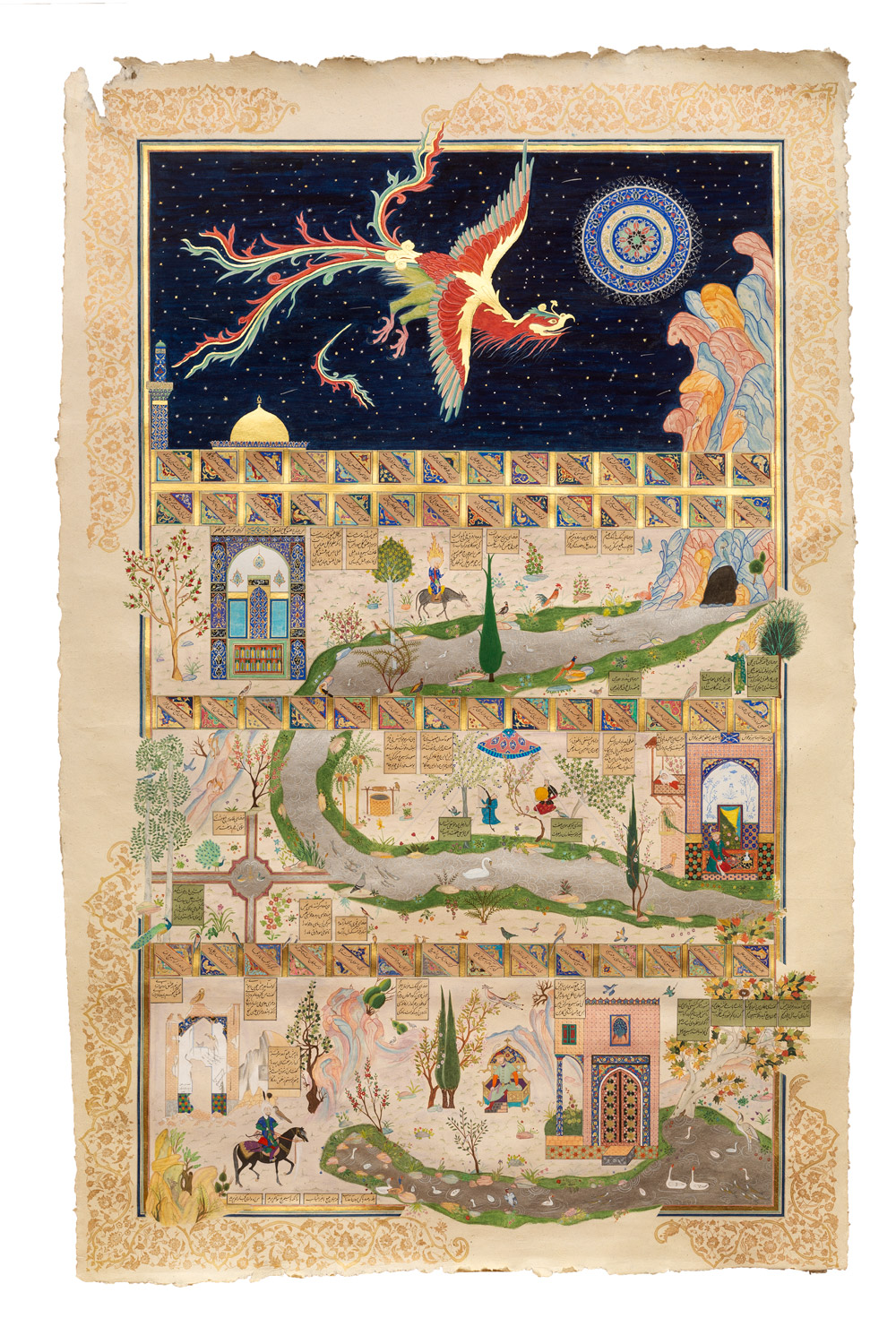Canticle of the Birds منطق الطیر
Panel No.1 Debating the Journey
This painting is the first in a tryptic by Farkhondeh Ahmadzadeh illustrating the 13th century epic poem titled Conference of the Birds by Attar of Nishapur.
When the world’s birds gather to discuss their lack of a sovereign, the wise Hoopoe suggests they seek the mythical Simorgh and in their excitement the birds swiftly appoint the Hoopoe as their guide and mentor in that quest. The elusive and majestic Simorgh lives atop the distant mountain of Ghaf, separated from the habitat of these birds by seven daunting valleys, each of which harbours a specific danger, that the Hoopoe describes as the journey’s challenges, in a metaphor for the path to enlightenment.
The birds’ initial excitement is swiftly dispelled by the risks implicit in this journey and they start making excuses as to why they cannot join Hoopoe, explaining how satisfied they are with their lives. Hoopoe challenges each bird separately, by way of telling them stories, and tries to convince them to take this first step along the path of self-discovery. After prolonged debates, many tales and parables recounted by the Hoopoe the birds eventually are persuaded to take flight. On their difficult and perilous journey, some of them die, and some of them change their minds give up and return. Only thirty birds survive the journey. Upon arrival it is then that they realise that “ Simorgh” is Persian for 30 birds: si morgh and that their quest has been to find themselves.
Attar’s epic poem is a doctrine to be studied and contemplated by students who wish to take the path of Sufism. It delves into many human characteristics and habits that are unconscious obstacles in our lives and illustrates the paucity in value of many behaviours we glorify.
This painting focuses on Attar’s introduction to the birds in his tale, illustrating some of the excuses they make to avoid the spiritual journey and some advice Hoopoe gives to aid their resolve. You can find these birds in the painting:
Owl, residing in a ruin, content with just the rumour of hidden treasures below. Hawk, proudly on a king’s wrist, self-satisfied and without desire to seek the real King, “Simorgh”. Duck, smugly floating on water preening clean white feathers sees no need to leave water behind. According to legend, anyone falling under the cast shadow of Homa, a mystical Persian bird, will become sovereign and given this power Homa sees no purpose in seeking out a King.. Heron suffers by the sea, not drinking a drop from fear of causing a drought – happy to remain in misery rather than fly away. Parrot enthroned in a golden cage is contentedly seeking immortality rather than risk a challenging journey. Finch, perched amidst apple blossom, embodies the music in all creation and is challenged to best that virtue in the pursuit of Simorgh. Sparrow complains of being too weak to withstand the long journey. Peacock, banished from paradise for letting the devil enter in the form of a snake, is obsessed to return and sees no other priority. Nightingale, perpetually in love with roses, cannot discard that passion and sings mournfully at the unrequited love as their bloom fades so quickly.
Hoopoe is a guide and mentor to the birds:
telling Pigeon while sat beside the river to shed the Self, identified by fish in Attar’s words; advising Francolin to observe how Jesus rides and dominates the donkey he rides and in that manner to ride rather than be ridden by Self and ego; counselling Falcon, drawn and painted from the artist’s dream one night, to release all negative feelings and rest in the cave of unity, where it is said the prophet took shelter; encouraging, Turtle-dove, next to the green robed Khizr, to stay loyal and grateful.
Above them all Simorgh flies in Attar’s midnight sky, and from just one feather drifting into an ether of nothingness, all life is created including the artist’s painting below
It was in China, late one moonless night,
The Simorgh first appeared to mortal sight-
He let a feather float down through the air,
And rumours of its fame spread everywhere;
Throughout the world men separately conceived
An image of its shape, and all believed
Their private fantasies uniquely true!
If this same feather had not floated down,
The world would not be filled with His renown-
It is a sign of Him, and in each heart
There lies this feather’s hidden counterpart.
Whoever wishes to explore the Way,
Let him set out- what more is there to say?

